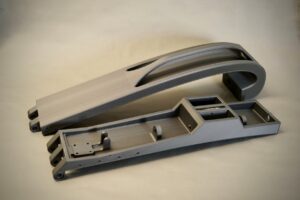A SMART SOLUTION FOR SAFE EMBARKATION
Rough seas not only make smooth sailors. They also make smooth engineers who can find innovative solutions to choppy conditions. This is especially true when it comes to aviation, as helicopters are frequently tasked with embarking onto ships during all different types of weather conditions.
Once helicopter flying operations have ceased, helicopters will either stay on the flight deck or be stowed in the ship’s hanger. Helicopters use automatic folding software, folding in their blades like a bumblebee. Nonetheless, the issue of stabilization remains a key priority when it comes to the smoothest embarkation possible. This is achieved by using a main rotor blade restraint cradle.
Nonetheless, as Gary Wilson, head of Technical Sales at their AeroAddtive division tells us: “When a helicopter is on board a ship, it has the facility to fold its helicopter blades back. Once the helicopter blades are folded back at sea, it’s still windy, and the blades can flap. So, these blades need to be restrained so this flapping doesn’t occur.”
For the aerospace and defense giant Leonardo – tasked by the Ministry of Defence to provide AgustaWestland AW101s for the Royal Navy – they found that their pre-existing main rotor blade restraint cradles were not living up to their standard. Leonardo turned to SFM Technology and their AeroAdditive section to provide a solution. The result was the first main rotor blade restraint cradle – measuring 900 x 230 x 160mm – created with 3D printing.

3D PRINTING PROVIDES THE SOLUTION
As a solution had to be found very quickly, SFM turned immediately to the possibilities of additive manufacturing. As Mr. Wilson says, “This is quite a long process, so we had a look at many aspects of 3D printing. We must look at cost, efficiency, and of course, the size, which pushed us to BigRep. Eventually, we looked at the BigRep PRO as we had to look at a production 3D printer, which I believe the BigRep PRO can provide. The machine is used as a production machine, so every rotor blade restraint cradle will be going to the end customer.”
3D PRINTING MORE VERSATILE THAN TRADITIONAL METHODS
In the aerospace industry, lightweight yet strong parts are essential. SFM Technology found through stress-testing that their 3D-printed printed parts performed better than original, non-printed parts. By using Hi-Temp CF – a carbon fiber reinforced material with versatile, high-strength properties – the blades have a powerful resistance to wear and tear as well as any external pressure.
The benefits have been manifold. As Mr. Wilson attests, “To date, we have printed 30 cradles, consisting of 60 halves, since January. If we were to do that in a traditional way, we would have done about a quarter of that. So, you can see that 3D printing is far quicker, as we don’t have any adjustments to make, or if we do, they’re very minor and can be quickly overcome. And the material is just as strong.”

THE ADVANTAGES OF HI-TEMP CF
Choosing the right material was crucial in SFM’s choice. As Mr. Wilson mentions, “We carried out many tests to establish which was the most suitable material within the budget given. Having looked at the data sheets, we felt that Hi Temp had a slight advantage over the other BigRep materials.”
Once they remove the support material, they use sandpaper and its equivalents to smooth the surface. Then bushes are inserted in the hinges, before using helicoil inserts when required. Once the cradle is painted to the customer’s specification, the rest of the metal parts are added along with the foam on the inside of the cradle, protecting the main rotor blade when the restraint cradle is fitted.
THE START OF 3D PRINTING IN THE AEROSPACE INDUSTRY
With the main rotor blade restraint cradles already in use, Mr. Wilson attests that this experience shows what 3D printing can achieve in the aerospace industry and that it’s only a matter of time before additive manufacturing becomes the norm. “In the aerospace industry, there are many designers still slightly nervous about 3D printing. By using these cradles, we can demonstrate that 3D printing can be used in the aerospace industry quite comfortably from a strength, repeatability, and quality side. I know for a fact, that as the industry gets more technically forward on 3D printing, certainly there will be more and more paths because of the accessibility to them.”
SFM Technology are now looking to use the BigRep PRO as a batch 3D printer, able to sequence production and create improved results across the board. It is likely that more aerospace designers will see the benefits of 3D printing and look to adopt it in due course.
About SFM TECHOLOGY
SFM Technology Limited is an independent, privately owned British company with an enviable reputation for expertise in developing and providing engineering solutions within particularly demanding environments, such as:
Aerospace | Automotive | Ministry of Defence | Nuclear | Transportation
First established in 1985 SFM started working with the fast-evolving Aerospace Industry and in 1997 expanded further into this niche area in both design and manufacturing services, the company has grown steadily since and nurtures a bank of design, engineering and support staff at its 4000m2 design and manufacturing facility in the village of Martock – Somerset.
About BigRep
A global leader in large‐format FFF 3D printing, BigRep strives to transform user productivity and creativity with easy‐to‐use additive manufacturing solutions. To help companies accelerate innovation and rethink manufacturing, BigRep’s German‐engineered 3D printers enable engineers, designers, and manufacturers from start‐ups to fortune 100 companies to go from prototyping to production faster, getting their products to market first. Through collaborations with strategic partners – including BASF, Bosch Rexroth, Etihad Airways, and Deutsche Bahn – BigRep continues to develop complete additive manufacturing solutions comprising industrial 3D printers, software, advanced materials, and services. Founded in 2014, BigRep is headquartered in Berlin with offices and technical centers in Boston, Singapore, and Shanghai.












































